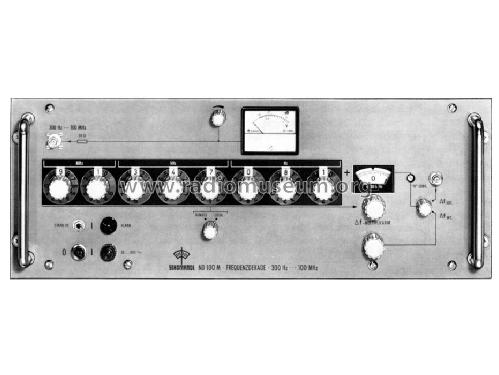Frequenzdekade ND100M
Schomandl KG; München
- País
- Alemania
- Fabricante / Marca
- Schomandl KG; München
- Año
- 1969
- Categoría
- Aparato de medida y servicio (Equipo de laboratorio).
- Radiomuseum.org ID
- 158176
-
- Brand: Meto
- Numero de transistores
- Hay semiconductores.
- Semiconductores
- Gama de ondas
- - no hay
- Tensión de funcionamiento
- Red / Baterías o pilas / AC 110; 220 / DC 18-30 Volt
- Altavoz
- - - No hay salida de sonido.
- Material
- Metálico
- de Radiomuseum.org
- Modelo: Frequenzdekade ND100M - Schomandl KG; München
- Forma
- Sobremesa apaisado (tamaño grande).
- Ancho, altura, profundidad
- 484 x 194 x 436 mm / 19.1 x 7.6 x 17.2 inch
- Anotaciones
- Die Frequenzdekade des Typs ND100M arbeitet im Frequenzbereich von 300 Hz bis 100 MHz und liefert eine Ausgangs-EMK von max. 1 Veff bei einem Innenwiderstand von 50Ω. Die Ausgangsfrequenz ist dekadisch in kleinsten Schritten von 1 Hz einstellbar. Sie wurde auch mit Schrittweiten von 10/100/1000 Hz geliefert. Über Zusatzeinrichtungen sind AM, FM und PM sowie die Wobbelung und eine elektronische Frequenzumschaltung für die Programmierung von Kanalfrequenzen möglich
Die Abmessungen gelten für das Kastengerät. Der Originalpreis gilt für das Kastengerät mit 10-Hz-Schritten im Jahr 1972.
- Peso neto
- 27 kg / 59 lb 7.5 oz (59.471 lb)
- Precio durante el primer año
- 19,970.00 DM
- Procedencia de los datos
- -- Original prospect or advert
- Mencionado en
- Funk-Technik (FT) (23/1969, S. 893 / Neuentwicklung, Werbeanzeige)
- Documentación / Esquemas (1)
- R&S-Datenblatt 444486 Ausgabe 02/1970
- Autor
- Modelo creado por Geert Schulte. Ver en "Modificar Ficha" los participantes posteriores.
- Otros modelos
-
Donde encontrará 61 modelos, 55 con imágenes y 14 con esquemas.
Ir al listado general de Schomandl KG; München
Contribuciones en el Foro acerca de este modelo: Schomandl KG;: Frequenzdekade ND100M
Hilos: 1 | Mensajes: 1
A guest has sent us a contact form with the following question:
Hello sir,
Do you know where to find information on an old type of frequency synthesizers. These were using multiple crystal oscillators, like very old CBs had, to achieve the different channels. Then I think they where using multiple bandpass filters, one for each oscillator, to filter out the signal. They were used on very low phase noise systems but they where quite expensive.
I do not even know what is the name of this technique?
A friend told me that it is like this one but I am not sure
http://www.radiomuseum.org/r/schomandl_frequenzdekade_nd100m.html
Do you have any information and/or schematics on this?
Thanks in advance
kostas Giann
Hopefully a member can answer him in the forum.
Maybe we also find more such models ...
Ernst Erb, 19.Nov.09
